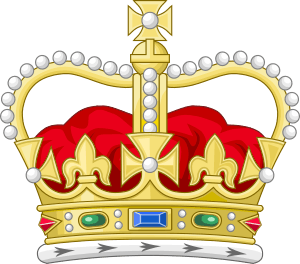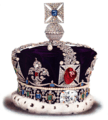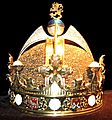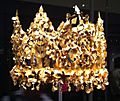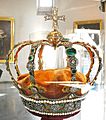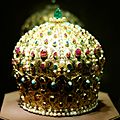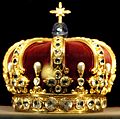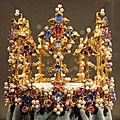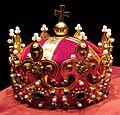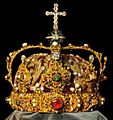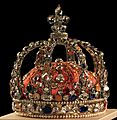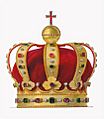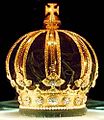Crown facts for kids
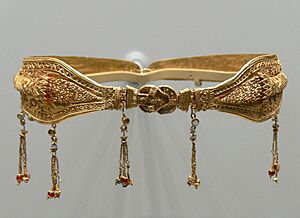
A crown is a special type of hat or headwear. It is usually worn by a monarch, like a king or queen. Crowns are often worn during important events, such as a coronation ceremony. They are also a strong symbol of royalty and power.
Besides being worn by monarchs, crowns can also be a symbol of winning. For example, winners of beauty pageants receive crowns. The word "crown" can also mean a prize or a reward. You might see crowns given out at contests or to the King and Queen chosen at a school dance.
What is a Diadem?
A diadem is a type of crown. It is a fancy headband worn by kings, queens, and other important people. A diadem shows that someone has royal status or is very important.
Images for kids
-
The Imperial State Crown of the United Kingdom.
-
The Papal tiara, worn by popes to show their authority in the Catholic Church. It was last used in 1963.
-
A ritual crown from Nepal, used by a Vajracarya priest.
-
The Seobongchong Golden Crown from ancient Silla. This 339th National Treasure of South Korea was found in 1926.
-
The crown of Darius the Great, around 500 BC.
-
An ancient Greek Kritonios Crown, likely for a funeral or wedding, from 370–360 BCE. Found in Armento, Basilicata.
-
The Holy Crown of Hungary (12th century).
-
The Crown of Wilhelm II of Prussia.
-
The Kiani Crown from Iran (Qajar dynasty).
-
The Pahlavi Crown from Iran (Pahlavi dynasty).
-
The Empress Crown from Iran (Pahlavi dynasty).
-
A replica of the Crown of Bolesław I the Brave from Poland. The original was destroyed.
-
A medieval crown from Bulgaria, kept in the National History Museum.
-
A Russian tsar's crown from the 14th century.
-
A reproduction of the Imperial Crown of Napoleon III of France.
-
The Imperial crown of a Chinese emperor from the Ming dynasty (1368–1644).
-
The Crown of Scotland (1540), kept at Edinburgh Castle.
-
The Makuta Binokasih, a crown from the Sunda Kingdom in West Java, Indonesia (14th century).
-
The crown of the Banten Sultanate, from Banten, Indonesia (16th century).
-
The crown of King Christian IV of Denmark (16th century), now in Rosenborg Castle, Copenhagen.
-
St Edward's Crown (1661).
-
The Crown of Louis XV of France.
-
The crown of the Kutai Kartanegara Sultanate, from East Kalimantan, Indonesia (19th century).
-
Imperial Crowns of the Heads of State of the Kingdom of Nepal (19th century).
-
The Palatine tiara of Pope Pius IX (19th Century).
-
The Imperial crown of Japanese emperor Emperor Kōmei (1831–1867).
-
The Imperial Crown of Brazil of Pedro II of Brazil (1841).
-
Crown of Flowers, a painting by William-Adolphe Bouguereau, 1884.
-
The Imperial Crown of India, worn by Emperor George V at his Delhi Durbar (1911).
-
The Tiara of Pope Benedict XVI (21st Century).
See also
 In Spanish: Corona (tocado) para niños
In Spanish: Corona (tocado) para niños


